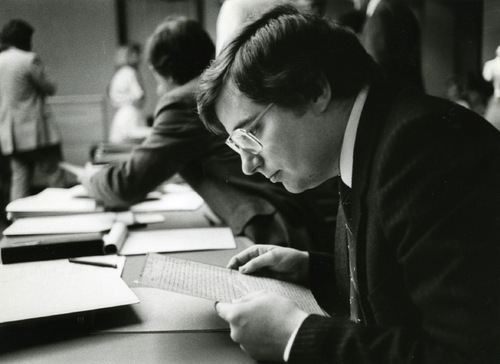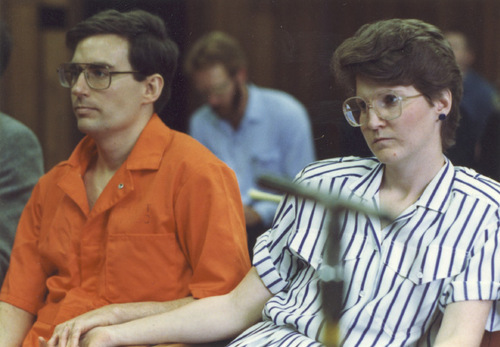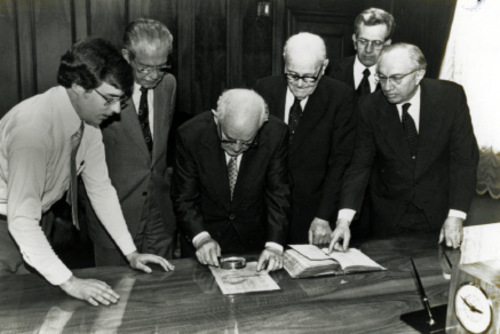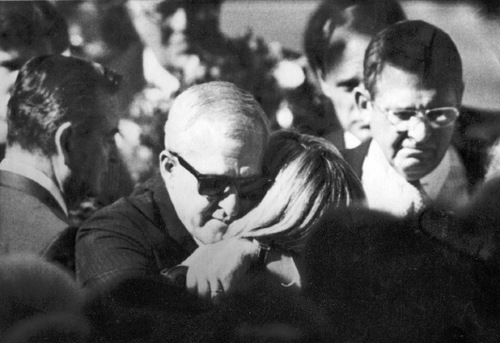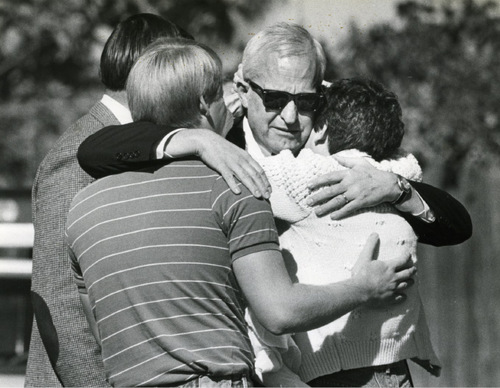This is an archived article that was published on sltrib.com in 2010, and information in the article may be outdated. It is provided only for personal research purposes and may not be reprinted.
Mark Hofmann's name looms large in Utah history and Mormon lore, castigated as an evil genius and a fraud who deceived his church, his friends and even his wife. But 25 years after the master forger murdered two people with nail bombs and sent Salt Lake City into a panic, he remains an enigma.
Despite a trove of books and scores of newspaper stories probing the Hofmann saga, no one is sure what forces shaped him into a liar and a killer and how he could do both so proficiently.
Today, Hofmann lives quietly at Utah State Prison in Draper, where he is serving a life sentence. He hasn't given interviews since Oct. 15, 1985, when a pair of explosions pierced the tranquil autumn day with bombs that reverberate still.
Outwardly, Hofmann was a mild-mannered family man and devout member of The Church of Jesus Christ of Latter-day Saints. But, as he later confessed, by the time he departed on a religious mission to Great Britain in 1974, he was a nonbeliever who saw LDS Church founder Joseph Smith as a fake who dabbled in magic. Hofmann's infamous Salamander Letter, among other documents, sought to undermine the Mormon prophet's credibility, while making its real author a big chunk of money. The letter, purportedly written to an early Mormon convert, described Smith conversing with a spirit that first appeared as an amphibian.
During the first half of the 1980s, Hofmann gained notoriety for discovering, one after another, documents purported to reflect early Mormon history. The forger later conceded he created material that could be embarrassing to the LDS Church in hope that Mormon leaders would spend large sums of money to keep them private. He also produced items attributed to Abraham Lincoln, Daniel Boone and Emily Dickinson, among many others.
Hofmann had a dual personality — a friend compared him with Dr. Jekyll and Mr. Hyde. But he never confided in anyone. That helps explain why his wife, family and friends defended him so vehemently when police began to suspect he was a forger and the cold-blooded bomber who killed businessman and documents collector Steven Christensen, as well as Kathleen Sheets, the wife of Christensen's business associate, Gary Sheets.
"It was like they were talking about someone else entirely. It was total disbelief," said former friend and book dealer Curt Bench of the aftermath of Oct. 16, 1985 — the day a bomb exploded in Hofmann's car, sending him to a hospital.
Hofmann said he was trying to commit suicide, but not everyone buys that.
"Who the real Mark Hofmann is is still a mystery," Bench said. "I've been trying to figure it out for 25 years."
—
A glimpse inside • But there are hints as to Hofmann's real identity and how — at least for a time — he fooled everyone.
He didn't testify in court. But in interviews with prosecutors at Utah State Prison — a condition of a plea bargain that allowed him to avoid the death penalty — he said he kept his real self hidden.
"It's hard for a lot of people to accept, I'm sure, that my closest friends and even my wife did not know the extent of my fraudulent dealings," he said. "But those people do not know my personality."
The 10 interviews conducted in 1987 by Salt Lake County prosecutors Robert Stott and David Biggs provide a rare glimpse into Hofmann's psyche. The 587-page transcript of those discussions deals mostly with the intricacies of his forgery techniques and his knowledge of Mormon history. But, occasionally, the pages provide chilling clues about the man who thought nothing of killing to keep his forgeries from coming to light.
In an April 22, 1987, recorded interview, Hofmann admitted that he liked manipulating people by challenging their deeply held beliefs.
"It's not so much what is genuine and what isn't, as what people believe is genuine," he told Stott and Biggs. "I don't believe in the religion as far as Joseph Smith had the first vision or received the plates from the Angel Moroni, or whatever. … To me, it is unimportant if Joseph Smith had that vision or not, as long as people believe it."
He rationalized that his forgeries weren't intended to defraud anyone.
"My view is, when I forged a document and sold it, that I was not cheating that person that I was selling it to because the document would never be detected as being a fraud."
Although he contradicted himself on a number of occasions as to his motives, in a Feb. 27, 1987, interview with prosecutors, Hofmann admitted that he sought to alter Mormon history. But he also conceded he wanted to make money.
"I believe the documents I created could have been part of Mormon history. … In effect, I guess the question I asked myself in deciding on a forgery, one of the questions was, 'What could have been?' "
—
No remorse for victims • A Jan. 29, 1988, hearing before the Utah Board of Pardons and Parole allows further insight into Hofmann's persona. A tape of the proceeding is filed at the Utah State Archives.
Then-Chairwoman Victoria Palacios probed his motivations for creating documents that seemed to question the origin of the LDS Church: "You seem to toy with the religious beliefs of others."
Hofmann replied: "Toying with them was an experimentation on my part, to see why they believe what they do."
Later, Palacios asked the soft-spoken inmate if he had any remorse for the murders.
"Part of my philosophy of life is that the victims are not suffering, at this point," he said without emotion. "I believe their families are. I feel remorse for their families."
Palacios pressed Hofmann about the second bomb he set as a diversion to make investigators believe Christensen's murder was related to his business association with Gary Sheets, rather than Christensen's dealings with the forger.
"When I made that bomb, my thinking was it didn't matter who died from the bomb," Hofmann said. "Mr. Sheets, a child, whatever."
After deliberating less than an hour, the board ordered that Hofmann remain in prison for the rest of his life.
If his friends and family were surprised by the forgeries, they were dumfounded by his admission to the murders.
"As a practical matter, he isn't knowable," said longtime friend Shannon Flynn.
Something was missing from Hofmann's personality, Flynn said.
"Most humans have bad thoughts from time to time and a control system that stops us from following through with them," he said. "Hofmann didn't have that. He wasn't a bloodthirsty individual, but if he got in a jam, there is nothing to stop him."
That hearing was the first and only time that Hofmann's ex-wife, Doralee Olds, heard him admit to the killings. She filed for divorce later that year.
All these years later, she said she doesn't know the real Mark Hofmann.
"I don't know if I can answer that question. There was some kind of disconnect," she said. "He was pretending to be someone else. Our life together was a fraud."
—
Attraction to explosives • Hofmann's past yields some clues to his pathological behavior, said Allen Roberts, who, with the late Linda Sillitoe, wrote Salamander: The Story of the Mormon Forgery Murders.
Hofmann had an early interest in explosives and felt empowered by fooling people with falsehoods, Roberts said. He also felt stifled by his authoritarian and religious father, who refused to allow his son to question the Mormon faith.
And Roberts noted that Hofmann read books such as The Word, by Irving Wallace Jr., and The Name of the Rose, by Umberto Eco, both of which feature plots with forgeries surrounding religious texts leading to murder.
Roberts believes Hofmann's background and his hubris allowed him to go beyond duplicity to murder.
"He fooled so many people at high levels for so long, he felt invincible," Roberts said.
Hofmann's run of famous document discoveries was glorious, if short — a little more than five years.
His first big "find" was the Anthon Transcript in April 1980. He traded the forgery to the LDS Church for a 5-dollar Mormon gold coin, several historic Mormon notes and a first edition of The Book of Mormon.
Salt Lake County investigators believe that, by the time of the bombings, he had made $800,000 in cash and $200,000 in trade from his forgeries.
But Hofmann weaved a web of deception that began to close in on him by mid-1985. Although he made a lot of money, he spent even more. By the late summer of 1985, Hofmann's debts mounted to a half-million dollars, and several anxious investors, including Christensen, were seeking the McLellin Collection — an assemblage of documents that would take months and months to forge.
The Oath of a Freeman, which Hofmann claimed to have found in New York City's Argosy Book Store and purportedly dated to 1638, was to be his ace in the hole. He figured it would bring $1 million. But his potential buyers, the Library of Congress and the American Antiquarian Society, eventually passed on the document.
During a March 17, 1987, prison interview, Biggs asked Hofmann what would have happened if he had collected the $1 million.
"It would have relieved me from [the financial hole]," Hofmann said. "Hence, I guess, you want me to say the bombings would not have taken place. … I'll say it's true."
But as October 1985 rolled around, the pressure finally pushed the baby-faced forger over the edge, according to one of his attorneys, Brad Rich.
Hofmann stared into the "amoral abyss and was cast adrift," Rich told the parole board.
"The decision [to murder] was the product of the moment," Rich said. "I think he doesn't know why he did what he did. He is astounded that he did what he did."
Hofmann hasn't said whether that's true. He recently declined an interview with The Salt Lake Tribune.
But his one-time friends don't let him off that easily.
"He knew exactly what he was doing. He killed to get himself out of a jam," Bench said. "I don't know how you could do that without remorse. It's about as cold as it gets."
Timeline: Mark W. Hofmann
May 1973 • Graduates from Olympus High School in Salt Lake County.
January 1974 • Goes on LDS mission to England.
September 1976 • Enrolls as pre-med student at Utah State University.
September 1979 • Marries Doralee Olds in the LDS Temple in Salt Lake City.
April 1980 • Forges the Anthon Transcript, which Joseph Smith purportedly copied from the golden plates.
February 1981 • Creates the 1844 Joseph Smith III blessing, where Joseph Smith says his son will succeed him.
July 1982 • Introduces the 1831 Lucy Mack Smith letter that says God told her son to dig up the golden plates.
October 1983 • Finds the Josiah Stowell letter in which Joseph Smith talks about seeking treasure with a divining stick.
February 1984 • Sells the Salamander Letter, which describes Joseph Smith seeing spirits with great kettles of money.
March 1985 • Forges The Oath of a Freeman and attempts to sell it the Library of Congress for $1 million.
September 1985 • Investors become upset with Hofmann over his inability to produce the McLellin Collection.
Oct. 15, 1985 • Kills Steven Christensen and Kathleen Sheets in separate bombings.
Oct. 16, 1985 • Hofmann seriously injured when a bomb explodes in his car.
Feb. 4, 1986 • Prosecutors charge Hofmann with murders and 25 other felonies.
Jan. 7, 1987 • Hofmann pleads guilty to two counts of second-degree murder.
Jan. 29, 1988 • Utah Board of Pardons and Parole sentences Hofmann to life in prison.


